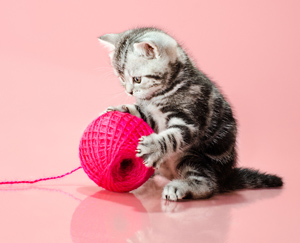kitten string Bigstock

It’s one of those Normal Rockwell moments. You’ve certainly seen it: a little kitten playing with a ball of yarn, perhaps beside a fire, and usually with a couple of pajama-clad kids watching and smiling beatifically.
Know what ER vets see when they look at that blissful scene?
A painful death from septic peritonitis. Sad but true.
The reason that scene is so iconic is because kittens love to play with string. My guess is that it’s something about the way it twists and curls in their grasp, mimicking the struggle of prey, which then stimulates their hunting instinct. (Or maybe they just like to play for play’s sake – not a lot of government dollars being spent on kitten research these days.)
And what do cats do with prey once it’s captured? They eat it. And that’s just where all the problems begin.
Dogs and cats eat foreign bodies all the time. Anything from toys, shoes or clothing to rocks and sticks is fair game. They basically consider the world edible unless proven otherwise. Lots of these objects pass through the dog or cat and emerge back out into the world with no problem. (They may be a bit smelly after the journey, but you see my point.) I have seen a large, lab-sized dog poop out an intact gym sock on more than one occasion. They seem to find those particularly tasty and ingest them with remarkable frequency. And you thought it was gnomes stealing your socks from the dryer! More than likely it’s your dog, perhaps in collaboration with the gnomes.
The propensity for dogs and cats to eat naughty things is one of the main reasons your vet may want to take an X-ray if you bring your pet in for vomiting. Dogs and cats can both suffer from a string-like thing, which vets call a linear foreign body. A cat’s natural tendency to play with string makes them more likely to be afflicted.
In some cases, however, those objects decline to re-enter the world from your pet’s backside and end up causing problems by blocking the intestines. This is potentially bad if your dog swallows a rock that plugs up the intestinal tract, but long, stringy things (known to vets as linear foreign bodies) are an especially dangerous form, since not only do they cause a blockage, they tend to saw through the intestines and cause intestinal contents (sort of proto-poop) to spill into the usually pristine and sterile world of the abdominal cavity.
Items other than string and yarn that can cause this blockage include, among others, dental floss, carpet fibers, tinsel, and ribbon.
If one end of the string gets hung up somewhere in the intestines, the rest of the intestines keep crawling along as if they were digesting food, inching along the string itself. The intestine ends up looking like a curtain bunched up on a curtain rod with the string being the rod and the intestines being the curtain. As the intestines move and try to push food along, the string quite literally saws through the wall of the intestines. Holes develop where the string saws through, and all of the bacteria pour into the normally-sterile abdomen, causing massive infection.
So now, perhaps you can understand the cringey response when an ER vet like me sees the pastoral scene of the kitten playing with a ball of yarn. To normal people, it would be like seeing a painting of a tot playing with a straight razor.
Linear foreign bodies are especially hard to diagnose. String or carpet, the most common offenders, don’t usually show up on an X-ray, so sometimes we have to look for the effects of the blockage: little bubbles and bunched up-looking intestines. Ultrasound can help diagnose it as well, but sometimes we are left with using surgery as a test, an exploratory surgery to find the problem and fix it. If infection has set in, the mortality rate becomes about 40 percent - definitely not a sure bet. For pets with a linear foreign body and no peritonitis, the odds of making it home are much, much higher.
Signs of a linear foreign body include vomiting, abdominal pain, lack of appetite and lethargy. Not very specific, but a good physical exam and testing can provide clues.
So if your pet – especially your cat – likes to eat things that aren’t food, it’s best to try and keep them from doing that. And if they have that habit and vomit more than once or twice, have your vet take a look, and make sure they know that your pet takes after the Norman Rockwell painting and likes to play with string. But if you’re just missing one sock, you might ask the gnomes first.